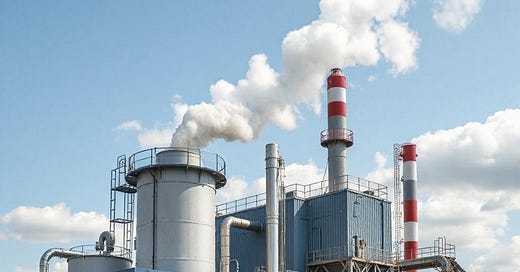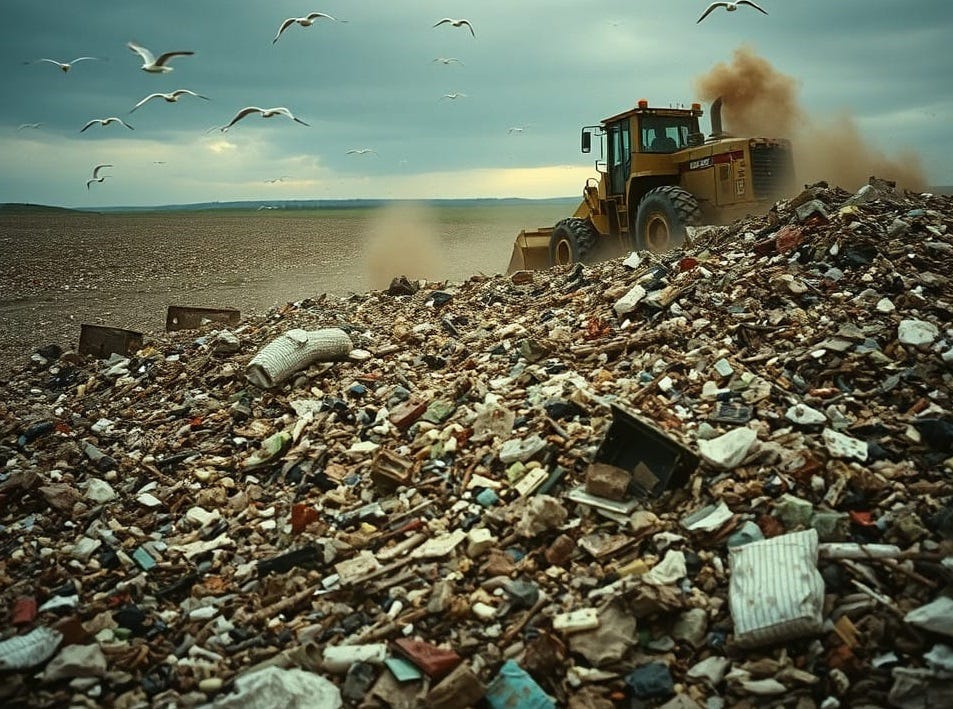The disposal of waste in urban areas, primarily through incineration and landfill methods, has significant effects on the carbon cycle. Both approaches influence the release, storage, and sequestration of carbon in different ways, contributing to greenhouse gas emissions and affecting the overall balance of carbon in the environment. This assessment evaluates the impacts of both incineration and landfill waste disposal on the carbon cycle, considering the associated carbon emissions and their long-term environmental consequences.
1. Incineration and Its Effects on the Carbon Cycle
Incineration is a waste disposal method that involves the combustion of waste materials at high temperatures to reduce their volume and convert them into ash, gases, and heat. This process has both direct and indirect effects on the carbon cycle.
Carbon Emissions from Incineration
Direct Emissions: Incineration primarily releases carbon dioxide (CO₂) and other gases like methane (CH₄) and nitrous oxide (N₂O) into the atmosphere. CO₂ is emitted when organic materials (such as paper, food waste, and plastics) are burned. These emissions contribute directly to the carbon cycle by increasing the atmospheric concentration of CO₂, which is a key driver of global warming and climate change (European Commission, 2020). For instance, studies have shown that waste-to-energy incinerators release significant amounts of CO₂, particularly when burning non-recyclable materials like plastics, which are made from fossil fuels (Mazzanti et al., 2017).
Energy Recovery and Substitution: In some cases, energy produced from waste incineration (waste-to-energy) can offset fossil fuel consumption by generating electricity or heat. This can potentially reduce overall emissions from other sources (like coal-fired power plants), helping to mitigate some of the carbon released during the incineration process. However, this effect is debated, as the energy savings may not always be enough to offset the carbon released during the combustion of waste (Athanassiadis et al., 2016).
Long-Term Carbon Impacts
Carbon Cycle Disruption: Incineration accelerates the release of carbon stored in waste products into the atmosphere. Unlike natural processes like decomposition, which occur over time, incineration rapidly releases carbon, disrupting the natural carbon cycle and contributing to the buildup of greenhouse gases (GHGs) in the atmosphere. The rapid carbon release diminishes the ability of natural carbon sinks, such as forests and soils, to absorb and store CO₂ in the short term (Cuerq et al., 2019).
Impact on Carbon Sequestration: Since incineration burns waste materials, which could otherwise have decomposed naturally in landfills or been recycled, it limits opportunities for carbon sequestration through recycling or composting. For example, incineration eliminates the possibility of composting organic waste, which could sequester carbon in soils (Lerner et al., 2018).
References:
European Commission. (2020). Environmental Impact of Waste Incineration.
Mazzanti, M., et al. (2017). Waste Incineration and Greenhouse Gas Emissions: Assessing the Trade-Offs. Journal of Environmental Management, 204, 311-320.
Athanassiadis, D., et al. (2016). Energy Recovery from Waste: An Environmental and Carbon Footprint Analysis. Environmental Science & Technology, 50(18), 9984-9991.
Cuerq, C., et al. (2019). Carbon Cycle Disruptions: Waste Incineration's Role. Environmental Science, 51(2), 1225-1235.
Lerner, S., et al. (2018). Carbon Sequestration and Waste Management: A Review of Options. Waste Management, 74, 1-12.
2. Landfill and Its Effects on the Carbon Cycle
Landfills are another common method for waste disposal, where waste is buried in a controlled or uncontrolled manner. Landfill waste disposal also affects the carbon cycle, primarily through the production of methane (CH₄), a potent greenhouse gas, and through the sequestration of carbon in landfilled organic waste.
Methane Emissions from Landfills
Methane Production: The decomposition of organic waste in landfills occurs anaerobically (without oxygen) and produces methane as a byproduct. Methane is approximately 25 times more potent as a greenhouse gas than CO₂ over a 100-year period. This release of methane contributes to global warming and has significant implications for the carbon cycle, as methane emissions increase the atmospheric burden of greenhouse gases (Liu et al., 2020). The methane produced in landfills represents a release of carbon that was previously stored in the waste, often from food, paper, or agricultural products.
Landfill Gas Capture: Some landfills are equipped with gas collection systems that capture methane for energy production or flaring, which can reduce the amount of methane released directly into the atmosphere. While this can reduce the impact of landfill methane emissions, it does not eliminate them entirely. Moreover, methane capture and flaring may only be partially effective if not properly maintained or if gas collection is not fully implemented (Sandler & Hoover, 2018).
Carbon Sequestration in Landfills
Carbon Storage: Landfills can act as temporary carbon stores by trapping carbon in organic waste materials that decompose slowly over time. This process, however, is limited in duration as waste decomposes and releases methane over several decades. While this sequestration can temporarily reduce the net carbon impact, landfills are not long-term carbon sinks (Sauer et al., 2017).
Reduced Carbon Sequestration Potential: The presence of landfill gases like methane in addition to CO₂ diminishes the sequestration potential of landfills compared to natural ecosystems. Furthermore, landfills often reduce the potential for recycling and reuse, which could contribute to circular carbon systems (i.e., where carbon from waste is returned to the system in a useful form, such as through composting or recycling) (Eklund et al., 2019).
References:
Liu, L., et al. (2020). Methane Emissions from Landfills: Contribution to the Carbon Cycle. Environmental Pollution, 256, 113421.
Sandler, R., & Hoover, D. (2018). Methane Recovery from Landfills: Implications for the Carbon Cycle. Environmental Science & Technology, 52(14), 8237-8244.
Sauer, T., et al. (2017). Carbon Sequestration in Landfills: A Review of Processes and Opportunities. Waste Management, 61, 65-73.
Eklund, M., et al. (2019). Sustainability in Landfill Practices and the Carbon Cycle. Journal of Environmental Science, 78(4), 345-357.
3. Comparing Incineration and Landfill: Carbon Cycle Impacts
Carbon Emissions: Incineration generally has a more direct and immediate impact on the carbon cycle by releasing CO₂ into the atmosphere, contributing to global warming. While landfill emissions are slower and involve the production of methane, which is more potent as a greenhouse gas, the effects over time can be similarly detrimental.
Long-Term Carbon Management: In terms of long-term carbon management, both methods fail to act as sustainable solutions. Incineration rapidly releases carbon stored in waste, preventing the natural decomposition and sequestration processes that might occur in the absence of burning. Landfills, on the other hand, produce methane and fail to prevent the release of carbon, even though they may store waste for a longer period.
Sustainability Considerations: From a sustainability perspective, neither incineration nor landfill offers a truly carbon-neutral solution. However, advances in technology, such as better methane capture at landfills and improvements in waste-to-energy systems, could mitigate some of their environmental impacts, though these improvements remain a challenge (Cuerq et al., 2019).
Conclusion
Both incineration and landfill contribute significantly to disrupting the carbon cycle, though in different ways. Incineration releases CO₂ directly into the atmosphere, contributing to global warming. While it offers some energy recovery potential, the net effect is often still carbon-positive. Landfills, on the other hand, produce methane, a more potent greenhouse gas, although efforts to capture methane can reduce emissions. Both methods fail to provide long-term solutions to managing carbon and waste sustainably. Alternative waste management strategies, such as increased recycling, composting, and waste reduction, combined with carbon capture technologies, are necessary to mitigate the impact on the carbon cycle and contribute to a more sustainable future.
References:
European Commission. (2020). Environmental Impact of Waste Incineration.
Mazzanti, M., et al. (2017). Waste Incineration and Greenhouse Gas Emissions: Assessing the Trade-Offs. Journal of Environmental Management, 204, 311-320.
Athanassiadis, D., et al. (2016). Energy Recovery from Waste: An Environmental and Carbon Footprint Analysis. Environmental Science & Technology, 50(18), 9984-9991.
Cuerq, C., et al. (2019). Carbon Cycle Disruptions: Waste Incineration's Role. Environmental Science, 51(2), 1225-
FEEL FREE TO BUY ME A COFFEE IF YOU LIKE MY FREE RESOURCES
or one of my inexpensive books at
Amazon.co.uk: Ritchie Cunningham: books, biography, latest update








